Video: Guide to selecting lambs for slaughter and minimising losses
Getting the best price for your finished lambs is not just about deciding whether to sell liveweight or deadweight, but about sending lambs that are in the right condition.
For further information about beef and lamb selection, see the AHDB Beef & Lamb BRP Virtual Selection Programme, which allows producers to see a computer-generated animal change conformation and fat class from every angle.
Weight is important, but it’s also vital to select lambs with appropriate fleshing and fat cover for the end market.
However, it can be hard to see beyond the fleece when stock is still on farm – so how do you logically select the best stock for maximum profit?
See also: Advice on calculating your lamb production costs
Peter Morris, a member of the AHDB Beef & Lamb selection team, explains the key areas to focus on when selecting lambs for slaughter.
Watch the video below.
Weight
Be accurate, use scales and select for your customer. This will typically be the meat processor, not the consumer. A specification from a processor will reflect a desired weight and grade.
The target weight is typically 16-21kg deadweight (see “Typical requirements for different markets”). Above 21kg, processors are unlikely to pay for the extra weight – so producers are essentially giving this away for free.
With a 5kg deadweight range to aim for, this gives producers roughly a 10-12kg liveweight span to work with.
Classification
Produce the right conformation and fat class for the meat processor. According to AHDB Beef & Lamb figures, 40% of prime lamb fails to meet the target market specification.
Producers are familiar with the Europ specification for conformation and fat score grid.
To assess the likely classification of a live lamb, it’s important to handle them to confirm what you can see with your eyes.
Typical requirements for different markets |
|||
|
Main market |
Carcass deadweight (kg) |
Classification |
|
|
Conformation |
Fat |
||
|
Supermarkets |
16-21 |
E, U, R |
2, 3L, possibly 3H |
|
Butchers |
16-25 |
E, U, R |
2, 3L, 3H |
|
Exports |
9-21 |
E, U, R |
2, 3L |
|
AHDB Beef and Lamb: Typical target requirements for different markets |
|||
Ribs
The ribs are a good indicator of the lamb’s level of fat cover.
Very gently part the wool on the ribs and then gently rub the ribs in the middle, applying a light pressure, to feel the fat cover.
For lambs you want a fat cover of 3L, meaning the individual ribs should have a soft feel, with fat cover evident between and over the ribs, which are now less easy to detect. If the ribs are easily detectable the fat cover is a 2 or less.
If you can only feel individual ribs with firm pressure it is a 4. If you cannot feel a rib the lamb is very fat.
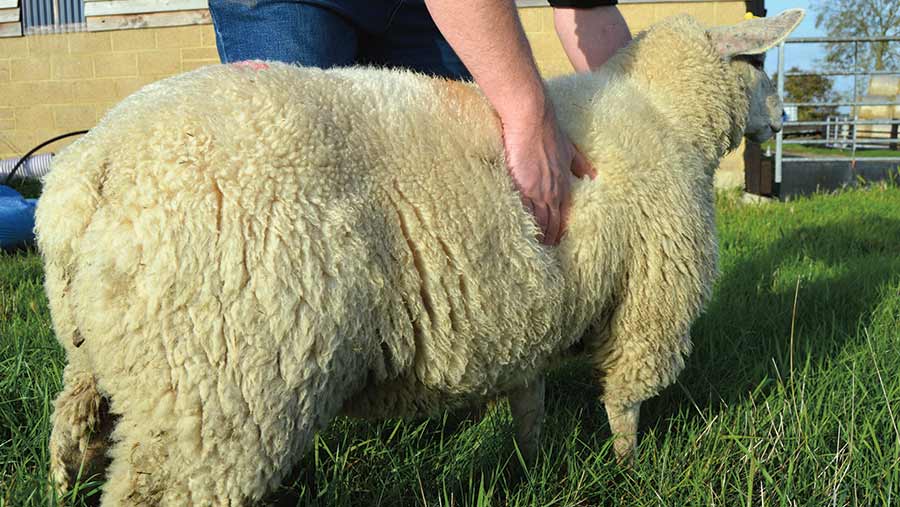
See also: Why on-farm ram auctions are growing in popularity
Dock
The dock indicates fat cover very clearly. The individual vertebrae will feel more prominent with less fat cover and as fat level increases, they will feel softer.
With moderate pressure producers should detect the individual bones on the dock, to indicate an 3L fat cover.
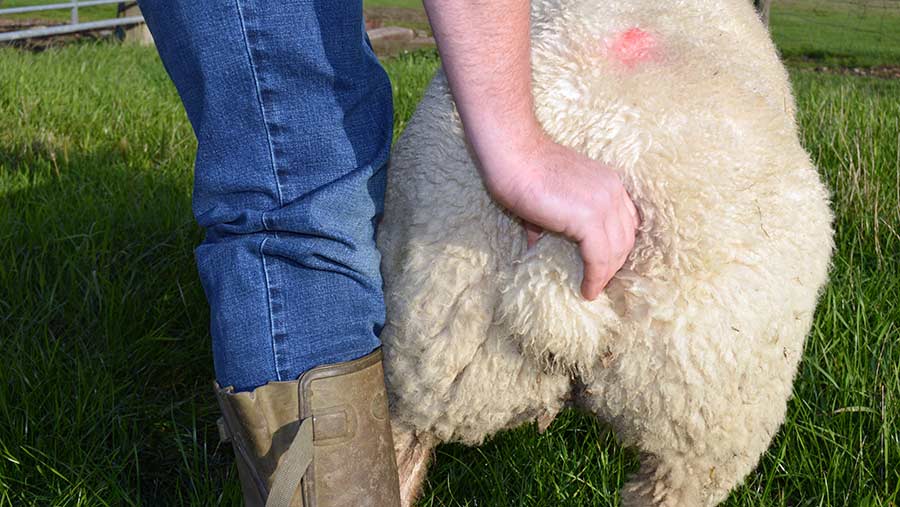
Shoulders
The fuller the lamb and the more fleshing it carries, the more rounded the shoulder will be and the less prominent the backbone will feel to a gentle touch.
Place a hand in the centre to feel the spinous process and how much muscling there is on both sides (see drawing below). You should be aiming for straight or convex (rounded) profiles so there is less prominent spinous process with muscling. An R grade suits 80% of the market place.
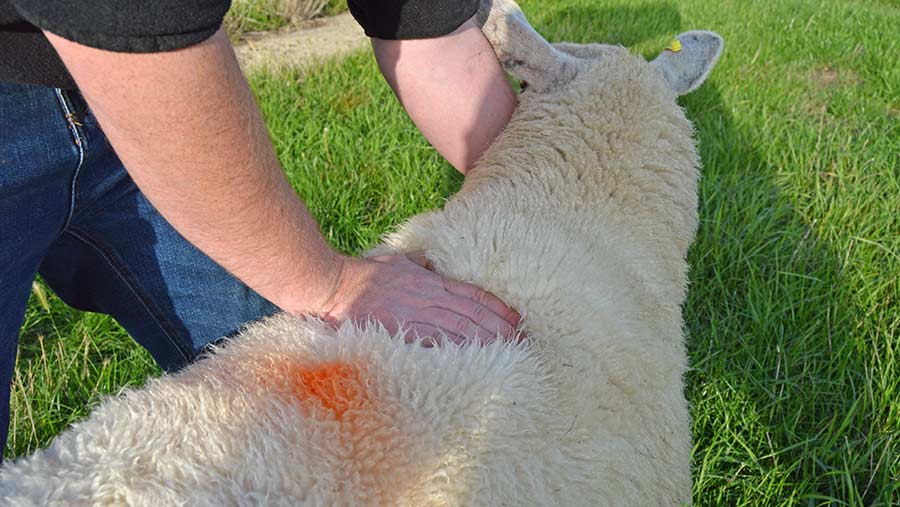
Loin
The softer the lamb, the higher the fat cover. Handle the loin similar to the shoulder by placing your hand in the centre of the loin to feel the spinous and transverse processes, using a gentle rocking movement.
Ideally for an R3L grade lamb the loin should feel less prominent and the tips of the processes should feel rounded. You should be able to still feel the spinous process with light pressure but if you need to use moderate pressure and cannot feel the ribs, the lamb is probably overfat.
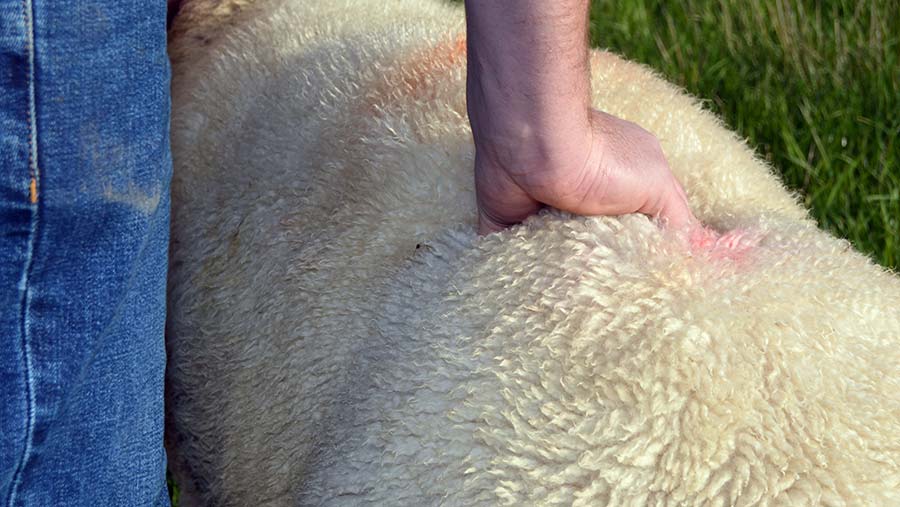
Breast
Though lambs can be assessed for fat cover here, the AHDB suggest avoiding this area as it involves the lamb being tipped over. It’s better to focus on the areas that are easy to handle while weighing.
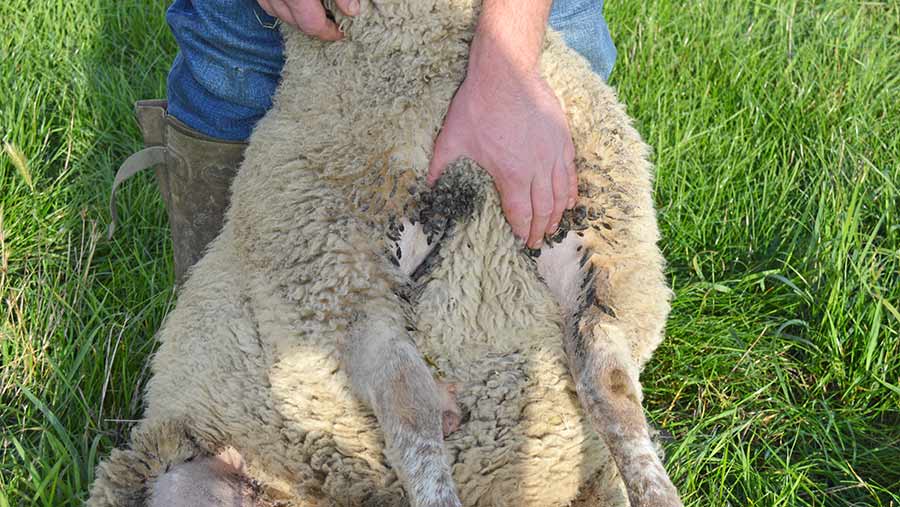
Six ways to minimise carcass losses
1. Wool pull
Sheep should always be handled with care, as mishandling leads to bruising damage that is visible after slaughter and can make parts of the carcass unusable.
Action: Handle lambs carefully around the head, neck, chest and feet, avoiding the back, flank and rear.
2. Injection sites and abscesses
Injecting a lamb poorly, whether at the wrong site or with a dirty needle, may result in an abscess. In the abattoir this area will be cut out at a loss to the producer because the lamb is weighed after this has been done. The producer loses the weight and the processor may have to use that cut as mince – so everybody takes a hit.
Action: Inject into the bloodstream or muscle depending on the treatment and in the neck with a clean needle, using the correct technique to prevent infection.
3. Cleanliness
Dirty lambs will not be accepted for slaughter for food safety and hygiene reasons. Dirty fleeces lead to carcass contamination and wet fleeces increase the chance of transferring bacteria.
Action: Make sure sheep are clean and presentable to avoid rejection. It may be worth clipping the belly of a lamb before sending it to the abattoir, but this an added cost and will depend on individual abattoir policies.
4. Sheep measles (Cysticercus ovis)
These are tapeworms from dog or fox faeces that cause cysts to form in the lamb’s muscles. While symptoms may not be visible in livestock, the damage to the muscles mean poor carcasses will go for dogmeat.
Action: Treat your dogs with a wormer every six to 12 weeks, restrict access to sheep pastures and remove dead stock quickly to avoid fox scavenging.
5. Bladder worms (Cysticercus tenuicollis)
The larval stage of tapeworms, picked up from dog and fox faeces. These produce big cysts that damage the liver, meaning the liver may have to be trimmed or condemned.
Action: Tackle using the same principles as for sheep measles.
6. Liver fluke (Fasciola hepatica)
Adult fluke live in cattle and the eggs are transferred to sheep through mud snails. These affect the live animal’s daily liveweight gain and damage the liver, meaning it cannot be sold for human consumption.
Action: Don’t graze likely affected areas and install drinkers to avoid natural watersources. Minimise pasture contamination through targeted treatment, but be aware that different treatments target different stages of fluke and some areas suffer from resistance. Speak to your vet for localised information.
